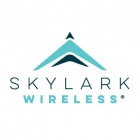From his 500-acre spread in Paige, just 50 miles east of Austin, Francisco Artes can send an email, check a website or two and conduct a chat session.
But there are some days when streaming video or participating in a teleconference is out of the question. Like a lot of folks with homes and businesses in rural America, Artes struggles with his internet connection – and really, he’s lucky to have one at all.
“We get maybe 1 (megabits per second) uploads, maybe 10-12 (Mbps) downloads,” he said. “It’s really hit or miss whether you’ll have a good Zoom call.”
Artes’ primary internet service uses a form of WiFi, beamed to an 80-foot tower on his land, where he operates a winery and a festival site. He’s supposed to be getting 25 Mbps for both downloads and upload.
Help may soon be on the way. Artes is testing a new kind of internet service being developed by a Houston startup called Skylark Wireless. It turns the unused frequencies normally associated with television stations into internet service, and it’s seen as a real possibility to get high-speed data service to people in rural areas who’ve had to do without for decades.
Known as TV white space technology, or TVWS, it already has sold Artes, who is now able to join those Zoom teleconferences without missing a beat.
“We’ve gotten speeds that at times were mind-boggling for out here in the country,” Artes said, adding he’s getting 30 megabits a second for both download and upload speeds. “We can’t wait we can start using it commercially.”
That could happen as soon as the end of this year or early next, say Skylark co-founders Ryan Guerra and Clayton Shepard. The company, which will license its technology to rural internet service providers, already has customers lined up to deploy it.
[…]
While other companies are using TVWS to do rural broadband internet access, Skylark’s approach is unique. It uses software-enabled radios that can be programmed to run on different frequencies, making the tech less expensive to configure and change as conditions and customer needs warrant.
Guerra, the CEO, and Shepard, the chief technical officer, say the same signals used for television are perfect for getting internet access to people in out-of-the-way places.
“The low frequencies in TV that are occupied by television broadcasters allow (the signal) to go much further and propagate through trees, buildings, materials, very well compared to other bands,” Guerra said. “In rural areas, the main challenge is to provide connectivity to people that are spread so far apart and in such difficult terrain. You have all the same challenges that television broadcasting has already solved: Getting through trees, going long distances, etc.”
That makes the signals that TV uses so valuable that they are referred to as “beachfront spectrum.” The Federal Communications Commission has allowed it to be used for data when it’s not being used for television, for the express purpose of solving the problem of getting internet access to rural areas.
In a city the size of Houston, there are literally dozens of television stations operating on many different channels. But out in the country, there may be only a few that can be received by TVs in any given area. The other channels go unused, which is why they are referred to as “TV white space.”
For example, Shepard said that Francisco Artes’ test setup is receiving internet service on what would normally be channels 53 or 58. Those channels are actually licensed for use in the area, but currently are not occupied. With permission from the holder of the frequencies – in this case, Lowell Feldman, a Skylark investor and CEO of wireless service provider Evolve Cellular – the startup is allowed to test on them.
True “white spaces” are frequencies that are unlicensed, and when Skylark Wireless goes commercial, it will be moving the technology to use those bands. That requires an FCC certification.
There’s more, so read the rest. Skylark is a Houston company with connections to Rice University. As the story notes, there are 21 million Americans (or more, depending on how you do the estimate) that lack broadband Internet access. This approach solves a lot of the technological challenges, which in turn should make it cost-effective. The big cellular companies are looking at this space as well, so perhaps there will be a viable solution soon. Given the need for remote learning and e-commerce these days, that can’t happen soon enough.

